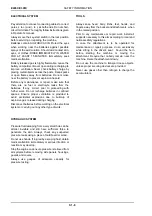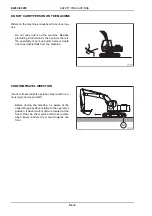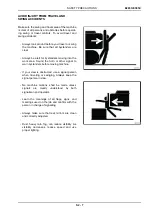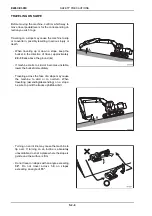
S1 - 1
SAFETY INFORMATION
E265C-E305C
SAFETY RULES
GENERALITIES
Read the Operator's manual carefully before starting,
operating, maintaining, fuelling or servicing the
machine.
Carefully read the explanation to each and all safety
signs in the special section of this Manual before
starting, operating, maintaining, fuelling or servicing
the machine.
Machine-mounted safety decals are colour coded
yellow with black borders when they refer to points
where special ATTENTION must be paid and failure
to observe them may cause a serious DANGER to
the integrity of machine operators.
It is fundamental that all machine operators know
very well the meaning of each safety plate as this
considerably decreases operating hazards and
accidents.
Do not allow unauthorised personnel to operate or
service this machine.
Do not wear rings, wrist watches, jewellery, loose or
hanging garments, such as ties, torn clothing,
scarves, unbuttoned or unzipped jackets that can get
caught in moving parts. Wear certified safety clothes
such as: hard hat, no-slip footwear, heavy gloves, ear
protection, safety glasses, reflector vests, respirators
every time the job requires it. Ask your employer
about safety regulations in force and protective
equipment.
Always keep the operator’s compartment, step
plates, grab-rails and handles clean and clear of
foreign objects, oil, grease, mud or snow to minimise
the danger of slipping or stumbling. Remove mud or
grease from your shoes before operating the
machine.
Do not jump on or off the machine. Always keep both
hands and one foot, or both feet and one hand in
contact with steps and/or grab rails.
Do not use controls or hoses as hand holds. Hoses
and controls are movable parts and do not provide
solid support. Besides, controls may be inadvertently
moved and cause unexpected movement of the
machine or its attachments.
Never operate the machine or its attachments from
any position other than sitting in the driver’s seat.
Keep head, body, limbs, hands and feet inside the
operator’s compartment at all times to reduce
exposure to external hazards.
Be careful of possible slippery conditions of the steps
and hand rails as well as of the ground around the
machine. Wear protective boots or shoes with the
soles made of highly no-slip rubber
Do not leave the machine until it has come to a
complete stop.
Always check height, width and weight limitations
which may be encountered in the working site and
ensure the machine does not exceed them.
Assess exact paths of gas ducts, water mains,
telephone lines, sewers, overhead and underground
electric lines and all other possible obstacles.
Such paths should be opportunely defined by
competent Authorities. If necessary, require that the
service is interrupted or said installations are moved
prior to starting the work.
Define the rear upperstructure swing area and
provide for opportune barriers to prevent access into
it.
Never exceed machine lifting capacity.
Remain within the limits shown in the loading
capacity chart which located on the machine.
STARTING
Never start or operate a failed machine. Walk all
around the machine before mounting.
Before operating the machine, make sure that any
possible dangerous condition has been properly
removed. Before starting machine, always check that
all controls are in the neutral position and the safety
lever is in the LOCK position. Immediately report any
malfunction of parts or systems to the maintenance
managers for proper action.
Prior to starting the engine, check, adjust and lock the
driver’s seat for maximum riding comfort and control
accessibility. Prior to operating the machine and/or
its attachments, check that bystanders are outside
the machine operating range. Sound the horn.
Obey all hand signals, safety indications and signs.
Due to the presence of flammable fluids, never
check fuel level, refuel, charge the batteries in the
presence of smoking materials, open flames or
sparks.
Adjust all rear-view mirrors for maximum visibility of
the area behind the machine.
Ensure that engine speed is appropriate to the job to
be carried out.
If any hydraulic control or system exhibits erratic
performance or responds abnormally, have the
machine checked for air in the system.
Air in these circuits may cause incorrect movements
with consequent accident hazard. Refer to the
Operator's manual about corrective action to be
taken.





































